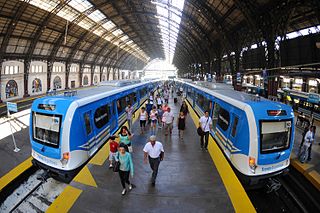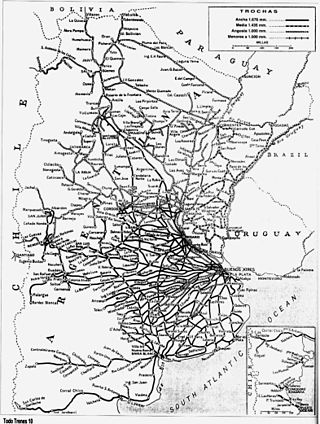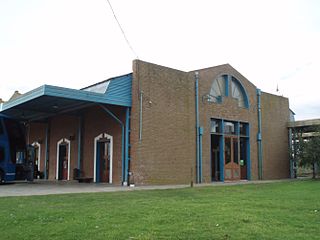
Ferrocarriles Argentinos was a state-owned company that managed the entire Argentine railway system for nearly 45 years. It was formed in 1948 when all the private railway companies were nationalised during Juan Perón's first presidential term, and transformed into the Empresa de Ferrocarriles del Estado Argentino.

Pinamar is an Argentine coastal resort city located on the coast of the Atlantic Ocean in Buenos Aires Province. It has about 45,000 inhabitants (2020).

Metropolitano S.A. was a privately owned consortium formed in 1994 to take over concessions granted by the Argentine government as part of railway privatisation during the presidency of Carlos Menem for the operation of commuter rail services in the Buenos Aires Province. Metropolitano operated the San Martín, Roca and Belgrano Sur lines until 2007.

The General Roca Railway (FCGR) is a 5 ft 6 in broad gauge railway in Argentina which runs from Constitución station in Buenos Aires to the south of the country through the provinces of Buenos Aires, La Pampa, Neuquén and Río Negro. It was also one of the six state-owned Argentine railway divisions formed after President Juan Perón's nationalisation of the railway network in 1948, being named after former president Julio Argentino Roca. The six companies were managed by Ferrocarriles Argentinos which was later broken up during the process of railway privatisation beginning in 1991 during Carlos Menem's presidency.

The General Manuel Belgrano Railway (FCGMB), named after the Argentine politician and military leader Manuel Belgrano, is a 1,000 mmmetre gauge railway and the longest of the Argentine system. It was one of the six State-owned Argentine railway companies formed after President Juan Perón's nationalisation of the railway network in 1948.

The General San Martín Railway (FCGSM), named after the former Argentine general José de San Martín, was one of the six state-owned Argentine railway companies formed after President Juan Perón's nationalisation of the railway network in 1948. The six companies were managed by Ferrocarriles Argentinos which was later broken up during the process of railway privatisation beginning in 1991 during Carlos Menem's presidency.

The Mitre line is an Argentine broad gauge commuter rail service in Buenos Aires Province and is part of the Ferrocarril General Bartolomé Mitre division. The service is currently operated by the State-owned company Operadora Ferroviaria Sociedad del Estado after the Government of Argentina rescinded its contract with Corredores Ferroviarios in March 2015.

The Roca line is a 1,676 mm gauge commuter rail service in the Buenos Aires Province, Argentina, part of General Roca Railway network. The service is currently operated by State-owned company Trenes Argentinos, from the city-centre terminus of Constitución south to Ezeiza, Alejandro Korn, La Plata, Cañuelas, Chascomús, Gutiérrez and Lobos, and west to Sarmiento Line's station Haedo. The transfer stations between the branch lines are Avellaneda, Temperley, Bosques and Berazategui.

The Belgrano Sur line is an Argentine 1,000 mmmetre gauge commuter rail service in the Greater Buenos Aires area, currently operated by state-owned enterprise Trenes Argentinos. The Belgrano Sur runs over tracks and through stations built by the Franco–Belgian-owned Compañía General de Buenos Aires and British Midland companies at the beginning of the 20th century.

Railway privatisation in Argentina was a process which began in 1989 under the presidency of Carlos Menem, following a series of neoliberal economic reforms. This primarily consisted of breaking up the state-owned railway company Ferrocarriles Argentinos (FA) and allowing the former lines to be operated by private companies instead of the state.

The Argentine railway network consisted of a 47,000 km (29,204 mi) network at the end of the Second World War and was, in its time, one of the most extensive and prosperous in the world. However, with the increase in highway construction, there followed a sharp decline in railway profitability, leading to the break-up in 1993 of Ferrocarriles Argentinos (FA), the state railroad corporation. During the period following privatisation, private and provincial railway companies were created and resurrected some of the major passenger routes that FA once operated.

Autovía 2 Juan Manuel Fangio is an Argentine dual carriageway, which runs from Buenos Aires to Mar del Plata. The road was a National Route until 1990 when it was transferred to the Government of Buenos Aires Province. The Autovía 2 extends from the junction of Provincial Routes 1 and 36 and National Route A004, just on the traffic circle "Juan María Gutiérrez", which is the limit of Berazategui and Florencio Varela districts.

Unidad de Gestión Operativa Mitre-Sarmiento (UGOMS) was a temporary consortium of Argentine companies formed on 24 May 2012 by Ferrovías and Metrovías to take over the running of the Sarmiento and Mitre commuter rail lines, after concessions granted to Trenes de Buenos Aires (TBA) in 1995 for the operation of these services were revoked.

Operadora Ferroviaria Sociedad del Estado (SOFSE), trading as Trenes Argentinos Operaciones, is an Argentine state-owned company created in 2008 to operate passenger services in Argentina. It operates as a division of Ferrocarriles Argentinos S.E..

Corredores Ferroviarios was an Argentine private company that operated the Mitre and San Martín railway services in Buenos Aires Province for about one year until the Government of Argentina rescinded the agreement with the company in March 2015. Since then, the Mitre and San Martín line are operated by State-owned company Operadora Ferroviaria Sociedad del Estado (SOFSE).

Chascomús is a railway station and bus terminus in the homonymous city of Buenos Aires Province, Argentina. Construction began on his station in 1983 when Raúl Alfonsín was President of Argentina but works were interrupted and finally cancelled until they were resumed in 2014 and the station was finished and opened to public on December 19. Station's facilities and services include railway platforms, bus garages, accessible toilets and a coffeehouse.

Bahía Blanca Sud is a railway station of the Argentine rail network, part of the General Roca Railway. Originally built and operated by the Buenos Aires Great Southern Railway, it is located in the city of Bahía Blanca, Buenos Aires Province. In November 2014 the station was declared National Historical Monument by the Argentine government.

Provincial Route 63 is a 29-kilometre-long (18 mi) Argentine road in the East of Buenos Aires Province. The road extends from Dolores, Buenos Aires to the "Esquina de Crotto", a paraje in Tordillo Partido.

Divisadero de Pinamar is a railway station in General Madariaga Partido of Buenos Aires Province, Argentina. The station was opened in 1996 as an extension of the General Guido – General Madariaga branch of General Roca Railway.

Pinamar was a railway station in the homonymous city of Buenos Aires Province, Argentina. Operated by recently created Ferrocarriles Argentinos, the station was opened in 1949 as an extension of the General Guido – General Madariaga branch of General Roca Railway, transporting tourist to the city of Pinamar mostly during Summer.
























